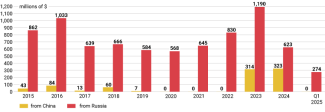Russia continues to export uranium to the United States
The United States continues to import low-enriched uranium from Russia, which is a key feedstock for producing nuclear reactor fuel. This trade takes place despite mutual restrictions: a US import embargo (in force since May 2024) and a Russian export ban (since November 2024). It remains possible due to one-off permits issued by both sides.
From Russia’s perspective, the lack of actual enforcement of the embargo on supplies to the US underscores the importance of Rosatom and its subsidiaries. Since 2022, the Russian authorities have refrained from using uranium deliveries as a political instrument and have allowed continued cooperation even with countries deemed hostile by the Kremlin – with the United States being the prime example. This suggests that, for Moscow, maintaining Rosatom’s standing in a key market and preserving its reputation as a reliable supplier are of critical value, as they facilitate operations in other countries. This is particularly significant in the context of bidding for contracts to construct nuclear power plants abroad – projects that create long-term ties between the host country and Russian state-owned companies, thereby deepening multidimensional dependency on Russia.
Commentary
- The Kremlin is using nuclear energy as an incentive to encourage cooperation with the United States. Vladimir Putin raised the issue of continued Russian uranium deliveries despite restrictions during a meeting with domestic business leaders on 13 May, noting that the United States still imports ‘nuclear fuel’ from Russia ‘despite everything’ and ‘for its own convenience’. A week later, Rosatom CEO Alexey Likhachev stated that the company was ready to cooperate with the US in uranium exports. This should be seen as part of ongoing bilateral negotiations, in which the Russians are leveraging American interest in potentially strengthening economic ties with Russia. For the Kremlin, the economic dimension is one of the instruments intended to prompt a shift in Washington’s current, critical policy stance towards Moscow.
- The likelihood of completely ending Russian uranium deliveries to the United States is diminishing – mainly due to the lack of alternative options and political considerations. Although exports of low-enriched uranium to the US declined last year, it is unclear whether this trend will continue. The reduction in 2024 stems from the record-high trade volume the previous year, driven by stockpiling in anticipation of potential sanctions against Russia. According to publicly available information, Tenex – a Rosatom subsidiary – was granted a licence to sell to the US, which led to deliveries being carried out in the first quarter of this year. Moreover, the company is applying for permits for the coming years, and its chances of success are bolstered by the United States’ significant dependence on enriched uranium from Russia (which accounted for just over 25% of total demand in 2023), combined with the relatively slow growth in production capacity among alternative suppliers. In addition, the prospect of phasing out this supply route is further undermined by the ongoing bilateral negotiations, which include discussions on the normalisation of relations.
- Russia is compensating for the decline in uranium deliveries to the United States by redirecting exports of enriched uranium to the Chinese market, indicating a deliberate effort by Rosatom to reduce political risk. Chinese customs data show a significant increase in uranium imports from Russia, both in terms of value and volume. Notably, this upward trend accelerated after 2022 and reached record levels in 2024. The large shipments recorded last year correlate with a sharp drop in exports to the United States. At the same time, the years 2023–2024 saw a sudden surge in Chinese uranium sales to the US. Previously, the scale of these exports had been much lower, and from 2020 to 2022, there were no deliveries at all. This dynamic suggests a degree of Russian adaptation to current conditions, enabled by Beijing. By importing Russian uranium while exporting its own production to the United States, China enables Moscow to mitigate the political risks that could arise from the actual enforcement of a US embargo. Interestingly, the sharp increase in uranium imports from China was noted by Washington and became the subject of an investigation launched by the Biden administration in 2024.
Chart 1. Chinese imports of enriched uranium from Russia, 2015–2025

Source: Chinese Customs Office.
Chart 2. US imports of enriched uranium from Russia and China, 2015–2025

Source: UN Comtrade.





